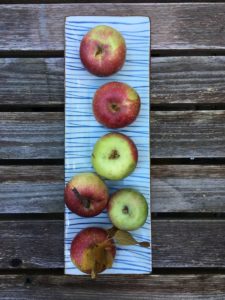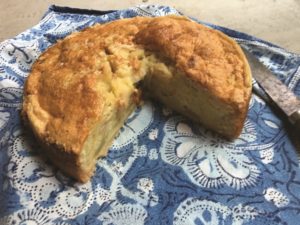Dessert as a last after-dinner thing has never made a lot of sense to me. Pie for breakfast was something condoned by my grandmother — and she gardened and cooked perfectly nimbly deep into her 90s (her one accommodation to old age being to cut holes in her sneakers so her bunions could breathe free).
Bacon on the side was not some kind of sin. It was just a common-sense addition to balance sweet with salty and make breakfast more complete.
Over the years, there have been studies that seem to back up my grandmother on this, but I’m pretty sure any sane doctor’s advice would be that fruit, nuts, and yogurt — not pie and bacon — are the way to do things right.

Still, now that it’s apple season, let’s assume you’re going to run through those first crisp Macouns and eventually want to bake something. Here’s what I think that something ought to be. It’s got a dreamy hint of lemon and pieces of apple that make it a substantial snack, perfect with a cup of coffee in the morning or at three o’clock in the afternoon.
Lynne Rossetto Kasper is the one who talked me into this cake, which has managed to beat out pie as far as baking with apples goes at our house. It was the description of her encounter with it at a small-town shop in Italy that got me. She wrote about the place where it was served, in her 1999 cookbook, The Italian Country Table: “The shop’s own homemade sausage and hams hung over the counter. Next to the front door was a little espresso machine and a table covered with a white cloth … on it sat a tray holding glasses and homemade liqueurs, a Saturday morning welcome to customers: have a coffee, chase the chill with a drink, stay and talk.”
Happily, the cake was nearby. People need a little sustenance if they’re going to shop and catch up on the news.
Rossetto Kasper mentions Braeburns in her recipe. They’re not an old-school New England apple. They were a 1950s introduction from New Zealand, a cross between Lady Hamilton and an unknown suitor. But they are grown here now, and popular for both eating and cooking — they’re dense and aromatic and hold their shape when baked. We know Braeburns grow on the Cape, too, because the ones that went into our first apple cake of the season came from our friend Edouard Fontenot’s tiny two-tree orchard in Truro.
The recipe’s machine-free stir-in-one-bowl steps are part of its old-world charm. There’s no reason to stray from it, but I don’t use vanilla, to allow the lemon zest to stand out a little more. And I don’t butter the pan because it ends up lined with a buttery, cookie-like crust on the bottom. Which is also why you do need a springform pan for this — it’s a single layer torte that you don’t turn out like you would an ordinary cake.
“Apple cake with a crackly meringue” is the English translation Rossetto Kasper gives this torte. The meringue is a last-minute addition: whip an egg white with a little sugar and spread it on top of the batter. That becomes — though for just a day, if you’re baking on Cape Cod — the crackly top layer.
Torta di Mele

Makes a nine-inch torte
2 cups plus 3 Tbsp. all-purpose flour
1½ cups plus 2 Tbsp. sugar
½ tsp. kosher salt
6 oz. cold unsalted butter
¾ cup milk
2 large eggs, plus one egg white
Grated zest of one lemon
1 Tbsp. baking powder
1 lb. apples
Preheat oven to 375 degrees F.
Zest the lemon and set the zest aside. Peel, core, and cut the apples in a large dice, then toss them with a squeeze of lemon juice so they won’t turn brown.
In a large bowl, combine the 2 cups flour, 1½ cups sugar, and the salt. Add the butter, cutting it into small pieces over the dry ingredients. Cut the butter in with your hands, rubbing and tossing until the mixture is crumbly.
Remove a heaping cup of the crumbly mixture and press it into the bottom of the springform pan and up the sides a half inch to make a crust.
Stir the remaining 3 tablespoons of flour, the baking powder, and the lemon zest into the crumbly dough in the bowl, then make a well in the center of the mixture. Drop in two of the eggs, add the milk, and stir them together, gradually pulling in the rest of the dough. Don’t overmix — the cake will come out more tender if you leave the dough lumpy.
Fold in the apples and pour the batter over the crust in the springform pan.
Last touch: whisk the extra egg white with that extra 2 tablespoons of sugar until it holds soft peaks, then spread the meringue over the batter.
Bake about 1 hour and 15 minutes, until the center tests done. Remove to a rack and slip the sides of the springform pan off the cake after it has cooled a little. Serve at room temperature.



